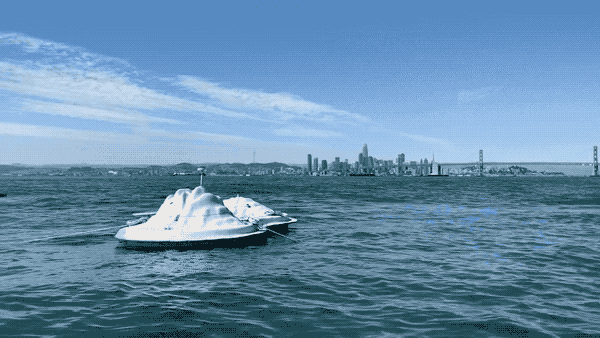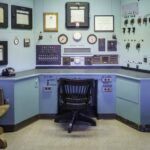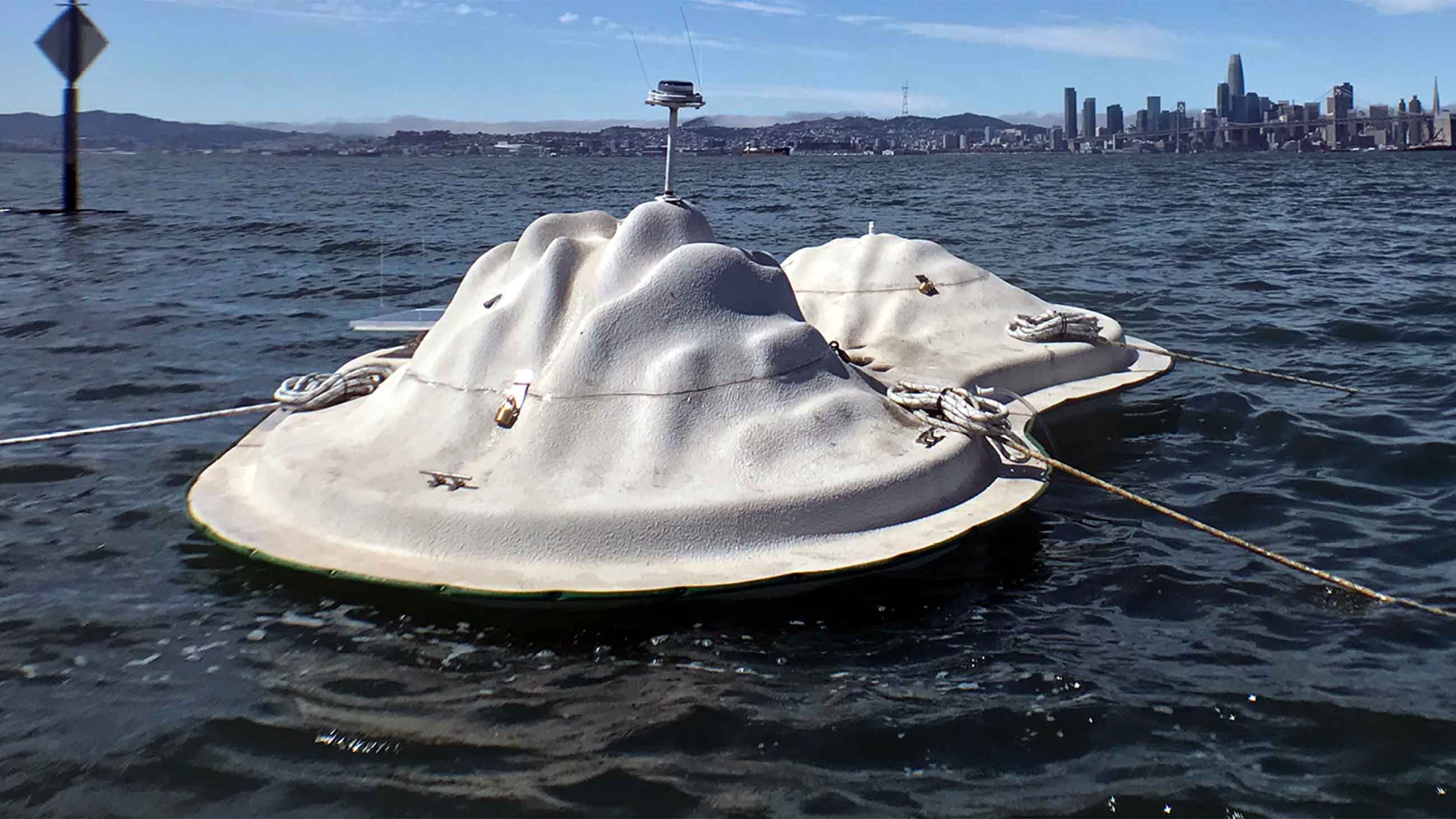Envisioning and Designing the Floating Future
On an August day that is brutally hot by San Francisco’s foggy standards, Margaret Ikeda and Evan Jones, architecture faculty at the California College of the Arts (CCA), are on one of the campus’ back lots to present a vision of the future — though at first glance, the object they’re showing off doesn’t look like much. It’s white, roughly heart-shaped, and about the size of a sedan.
As a prototype for what the underside of a floating building — or possibly a whole floating community — might look like, however, it represents years of imagination, research, design, and testing. It also represents the hopeful vision of Ikeda, Jones, and their CCA colleague Adam Marcus, who together developed the concept with an eye toward a future of flooding amid steadily rising seas — particularly for the 10 percent of the world’s population that lives in low-lying coastal areas.
Officially, it’s called the Buoyant Ecologies Float Lab, and just a few weeks later, after a lengthy design and permitting process, the team moved the prototype to its new home in San Francisco Bay’s chilly waters. The goal is to have it remain there, a few hundred feet offshore of Middle Harbor Shoreline Park in Oakland, for three years, by which time the team hopes to have proven its viability as a potential substrate for the futuristic — and some critics of floating city models say misguided — effort to move at least some communities displaced by climate change out onto the water.
They also suggest that linking together floating structures like their prototype could help to make marine ecosystems healthier. It could also protect coastlines from further erosion in the near term, which will be crucial to places like the San Francisco Bay Area where large tracts of densely-populated land are expected to start sinking into the sea in the coming decades.
Whether or not they’re right, of course, remains to be seen, but Ikeda, Jones, and Marcus are eager to test their concept. “We want to show how floating artificial structures can coexist with living ecosystems,” says Marcus.
And although they acknowledge the path from their current prototype to the design and construction of habitable buildings on the water may be long, they also say that if humanity isn’t going to stop burning fossil fuels and heating up the planet, the time to start preparing workable adaptations that benefit both people and the natural environment is now.
The Float Lab grew out of a series of design studios taught by Ikeda, Jones, and Marcus. In them, students explored a question that is at once straightforward and visionary: In anticipation of rising seas eating away at the land, would it be possible to design floating buildings that provide habitat for humans while protecting — and perhaps even enhancing — marine ecosystems?
Climate change, after all, is already affecting all of the world’s oceans, which absorb up to 95 percent of the excess heat that human industry is causing. The result: habitat loss for marine species, ocean acidification, widespread coral bleaching, and even changes in ocean currents. And as the team learned from early conversations with scientists, giant floating cities — like anything that floats, from boats to docks to barges — would be likely to attract barnacles and other invertebrates. Known as “fouling communities,” they’re often homogenous and seen as nuisances that can push out native species over time. Indeed, there’s evidence to suggest that as oceans warm, invasive species will begin to dominate these fouling communities.

After studying the problem, however, the team hypothesized that if an underwater surface had more peaks and valleys, it might act like an upside-down coral reef, both expanding the habitat and encouraging a greater diversity of species to settle.
Between 2014 and 2018, students in CCA’s Architectural Ecologies Lab worked with scientists from the Benthic Lab at the California State University System’s Moss Landing Marine Laboratories to design various prototypes, which were made at scale from fiberglass at Kreysler & Associates, a Bay Area composite fabrication company. Tests of these prototypes in Monterey Bay and San Francisco Bay showed that, indeed, a greater variety of species settled on the ones with more surface variation.
The design worked because “the peaks and valleys [are] going to create water dynamics that will enhance fouling communities,” said Brian Tissot, a professor and researcher at Humboldt State University who studies benthic ecology — the animals, plants, and microbes that live at the bottom of a body of water — and is not associated with the project. The greater variety of seaweeds, barnacles, and other filter feeders will, in turn, attract larger creatures, like crabs and fish, creating a vibrant ecosystem.
These early prototypes informed the design of the Float Lab, today a 14-foot long, 9-foot wide structure with top and bottom sides that look something like topographic maps: Each side has two “mountains,” one slightly shorter than the other, with a valley in between, and each of the mountains is made up of smaller peaks and valleys. On the underside, these variations in elevation create diverse spaces for invertebrates as well as “fish apartments,” where smaller fish can hide from predators. The top side, which will float just above the surface of the water, is equipped with a solar-powered pump that brings seawater up to the peaks and lets it filter down into the valleys, mirroring a tidepool habitat.
After testing the prototypes, the team behind the Float Lab felt confident that it could create diverse and healthy underwater ecosystems. But Marcus says the team also realized that with a few careful design tweaks, these structures could potentially counteract the effects of climate change in a more direct way.
For years now, as climate warnings have grown increasingly dire, governments worldwide have been scrambling to figure out how to address sea level rise. But a study published in Nature Communications earlier this year warned of another global warming hazard coastal communities will have to face: increasingly forceful waves. The study found that climate change has been making waves more powerful by 0.4 percent annually from 1948 to 2008.
Waves are the primary force behind coastal erosion, and as they get stronger, they will eat away at fragile shorelines more quickly, threatening not only human infrastructure, but also crucial nearshore habitats. Bluffs and shorelines can be protected with seawalls and rock barriers, but these defensive solutions do nothing to actually dampen wave energy.
For that, scientists are turning to nature for inspiration. Even before the results of this study were published, people were experimenting with solutions like rebuilding or creating artificial oyster reefs, which are known to help prevent erosion. One such example that has garnered significant attention is the “Living Breakwaters” project designed by the New York- and New Orleans-based landscape architecture firm SCAPE. It proposes coupling artificial breakwaters with oyster habitat restoration to protect Staten Island’s battered coastline, and in 2014 was one of six winners of the U.S. Department of Housing and Urban Development’s Rebuild by Design challenge.

The Float Lab, its advocates argue, has a unique advantage over that project and other artificial reefs: It is mobile. That’s key because “this could offer a more agile and more flexible, more customizable and scalable alternative to the kind of huge defensive barriers that many cities are thinking about, or even many cities are building, right now,” Marcus said.
As currently designed, there isn’t much inherent to the Float Lab’s structure that would blunt a wave. But to help with that, the team plans to attach long tubes to the bottom of the structure, making it look like a windchime — or perhaps a giant jellyfish. It adds a new dimension of utility so that “when you place the columns or the tubes close to each other, like let’s say six to eight to ten inches apart, the invertebrates attach on all sides,” Marcus says, explaining, “they just kind of create this giant sponge of animals.” Scientists from Moss Landing’s Benthic Lab plan to dive below the Float Lab every month for the next three years to assess whether these columns actually soak up wave energy.
Tissot sees clear ecological benefits to the columns. He says, “adding more structure that’s vertical would definitely increase the likelihood that you’re going to get a lot of fishes that will come in there. They love that kind of habitat.” But he’s unsure how far they will go towards absorbing wave power, saying “my guess is that’s pretty small to actually have much of an effect.”
Marcus acknowledges that how well they will work is still unknown, explaining that “in order for it to develop significant wave attenuation capacity you would need many of them kind of arrayed in a necklace or a network parallel to the shore.” The full Float Lab team plans to plug the data they gather into computer simulations to project the impact a whole fleet of Float Labs might have. Renderings imagine them clustered together in threes, blooming over a body of water like a field of clover.
Despite the modest near-term ambitions behind it, the Float Lab prototype bobs along in the wake of a long and controversial history of schemes to create utopias out on the water. Many have centered around the concept of seasteading, the idea of establishing new floating societies that exist outside the jurisdiction of national and international law. In fact, the most notable and best-funded of these groups, the Seasteading Institute, is also based in the San Francisco Bay area. Founded in 2008 by libertarian activists Peter Thiel, the billionaire co-founder of PayPal, and Patri Friedman, a grandson of Nobel-prize winning economist Milton Friedman, the non-profit’s vision of “freedom on the high seas” is as much about building a new society based on the free-market ideals of fewer regulations and lower taxes as it is about grappling with the impacts of climate change.
“We do distance our work from that,” says Marcus. “There is a big difference in agenda. One is about tax havens and cryptocurrencies. Ours is about multi-benefit solutions for both humans and animals.”
Regardless of political motivations, all floating city proposals face the problem of scaling up quickly enough to represent a meaningful solution for the nearly 187 million people around the world now projected to be displaced by rising sea levels in the coming decades. For now, the Float Lab team is focused on demonstrating the viability of just a single link, but their system is designed to be modular, and imagining a future in which coastlines, harbors, marshes, and other sensitive areas are protected by chains of Float Labs is made more plausible by the way they are designed and manufactured.
Because it is made up of just two pieces — plus some finishing touches, like cleats for its anchors — it would be relatively easy to churn out Float Labs by the hundreds or thousands. And they’re designed to last. Fiberglass has been used in boatmaking since the 1940s and is one of the most durable materials in marine construction; it doesn’t corrode or rot. “The first fiberglass boat ever made is probably still floating around somewhere,” says Bill Kreysler, the founder of Kreysler & Associates, the firm that helped fabricate all the prototypes and the Float Lab.
With the Float Lab launched and officially unveiled in late September, the team from CCA is already thinking about a more ambitious extension of this work. In late July, Jones and Ikeda visited the Maldives, where they and their students have been working with local partners since 2017 to imagine what a floating community could look like — a much-needed adaptation in a country that sits just about 5 feet on average above the current sea level.
The work is all still theoretical, but the vision — like that behind the Float Lab — is expansive. Renderings show pods of interconnected floating structures, pulsing with life both on the inside and below the surface. Sun streams down through skylights, flooding the buildings and artificial light attracts plankton in the ocean below. Seaweed and algae cling to the underside, while fish seek shelter behind the stalactite-like underwater mountains. Shorebirds nest on the roof next to solar panels and a rainwater catchment system.
This vision for the Maldives, the team suggests, will evolve over the coming years as lessons pour out of the Float Lab. “This is really studying how modular structures could link together to create communal systems,” says Marcus.
Lindsey J. Smith is a science and environmental journalist based in San Francisco. Her work has appeared in the San Francisco Chronicle, The Verge, and Pacific Standard, among other outlets.











Comments are automatically closed one year after article publication. Archived comments are below.
How about trying a version of this to replace the ever-diminishing ice in the Arctic? Perhaps polar bears, walruses and seals could haul out and rest on platforms such as these? Obviously the very different temperatures up north (or in Antarctica) might impact the fiberglass, but it’s worth experimenting with in order to save these creatures.
mexico city was a bunch of floating islands on a muddy swamp lake half a millenia ago or more. it filled in. sediments are a pain.
in a potentially flooding /sinking city scenario my money is on technology allowing existing buildings to more easily flood the basement while building up to compensate. the venusian model lasted many centuries and modern tech makes it far more viable.
building floating cities has never really worked and nothing has yet demonstrated it can. cities that are just built on top of their previous basements have existed all over the world, at various times not even because of flooding.
finding better ways of BUILDING UP is the sensible solution. for example. you could triple the available space in manhattan simply by building no higher than 15 floors up over every city street and highway. not even skyscraper height, it can be done with wooden beam construction too. the problem is politics and property rights not per se technology at this point. building in water, useful water that is not drinking water (rivers and lakes) , means building in the ocean or estuaries.
that is a MASSIVE challenge , one with a more than checkered past, and a graveyard littered with the bodies of stupid ideas (blue seed isn’t the least of them).
you’d bee better off simply building cruise ships designed for long term habitation. it’s been tried, it’s expensive, but it can work. the other alternative is revitalizing old oil platforms. they are too expensive to build a new, but not a bad idea to turn them into floating stations to support cruise ships, refueling at sea, and sea support in general.
seasteading is a great mindset but a horrible literallism.
sinking a spar somewhere and floating in the ocean. on a building size bouy is a research project, not a way to survive nor thrive.
disclosure, former boat owner and houseboat resident.
my 2 cents, ask someone advocating seasteading how many nights they’ve slept on a small or big boat, at sea, or in port docked.
While fiberglass doens’t corrode or rot, it does decompose under UV light. A canoe stored in sunlight will get brittle in about 10 years. Mind you — ocean boat hulls are thicker. Degradation of plastics generally can be slowed down a lot by adding carbon black to the resin. The carbon absorbs UV very well.
A firmly anchored float island should be able to incorporate a wave energy machine.
I would suggest a different experiment: Build a houseboat community. Basically make a marina with sewage, water, and electrical hookups. The marine equivalent of an RV park. Given the extreme pricing of housing in the California area, this might easily become popular.
Intriguing. Am sure the floating lab will evolve and have many important and exciting uses regardless whether human communities live off shore. Permanent floating labs to test currents, water temperature, components and micro organisms across seasons and years could alone make important contributions to science. Very worthwhile research!
In the 5th paragraph the entire article stops for me. Why read about all the research, hope, design on the outcome of research when the writer states they don’t really believe what’s actually happening around the globe! “whether or not that will happen remains to be seen?”